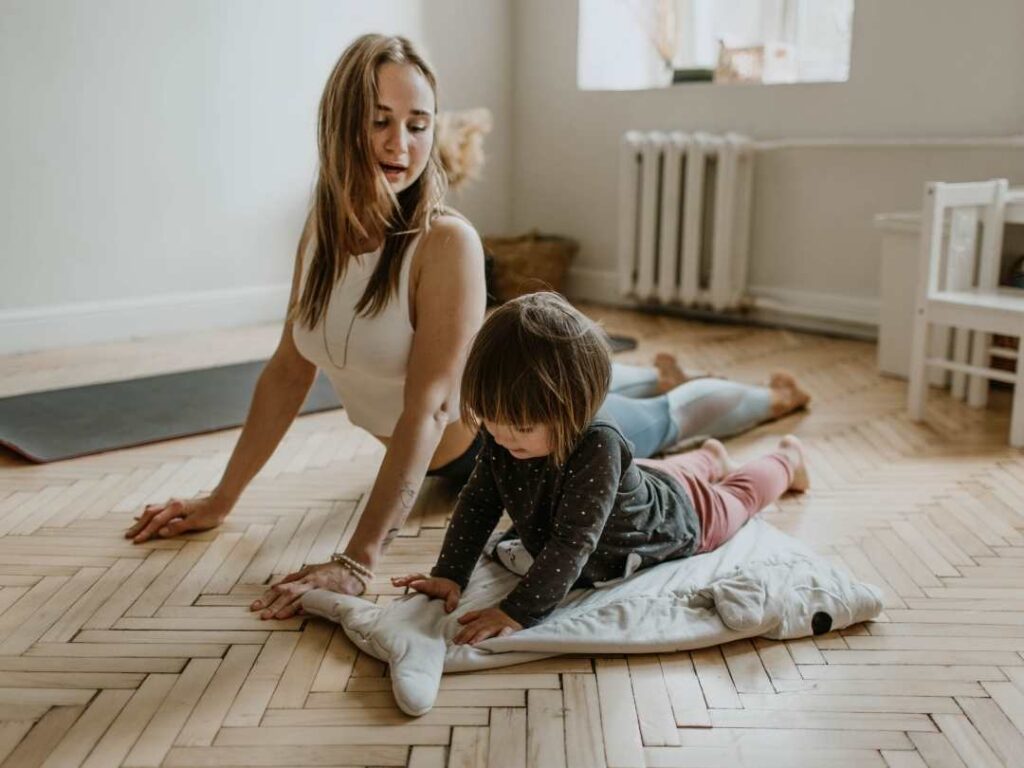So what can yoga do for me when I’m stressed at work?
Work and workplace environments are common sources of stress, so given that we now know the potential benefits of yoga, how can we incorporate it into a working day? Ultimately, the more regularly yoga is practiced, the greater the benefits on our overall wellbeing at any time. It helps to get into the habit of a regular practice where possible (even if only a few minutes per day), much like brushing our teeth on a daily basis benefits our dental hygiene. Therefore, the benefits of any practice of yoga outside of work will extend to the workplace too. Here are some ideas for incorporating practices from the eight branches of yoga at work.
Identify Yoga Time

If you are able to take some time during a lunch break, you may like to use the opportunity to practice a short yoga flow that incorporates both the psychological and physical benefits.
- Find a space you can do this (perhaps outdoors in the summer, or an empty office).
- Practice on your own, or invite colleagues to join you – perhaps it can become a new office habit together where you can additionally reap the benefits of connection through community. Before the pandemic had us working from home, some colleagues and I would enjoy gathering for just 10 minutes of gentle flow together before eating our lunch. It was a lovely way to connect to our bodies and feel we were offering nourishment to ourselves, alongside each other.
- Follow a guided practice – you can find some excellent free online resources to do this. One of the most well-known is ‘Yoga with Adriene’ on YouTube, who offers hundreds of free videos ranging from just 5 minutes up to a full hour of practice. She categorises her videos so you can find one matching what you feel you are in need of, for example: for managing stress, anxiety, anger, or boosting energy.
Breathe

Take a moment to pause. Place one hand over your heart and the other on your belly. Your eyes can be closed, or open with gaze lowered if it’s more comfortable for you. Take a long, slow breath in through the nose, filling your belly with air and feel your hand gently rising here as you do. Pause for a moment at the end of the inhale, then breathe out as slowly as you can, gradually releasing the air from your lungs. Feel the warmth of your hand directed into the heart. You could also add a mantra here, if you wish. Notice how you feel after a few rounds of this. Another great technique to promote a calming connection between mind and body is Alternate Nostril Breathing, which you can find a demonstration of here.
Mindful self-compassion

When you next grab a cup of tea or coffee, see if you can use this moment to tune into the sensations as you make yourself a drink: the smells, the colours, the sight of the steam rising, the heat from the mug… Notice this as a moment of reconnection between your mind and body, and a moment of practicing ‘santosha’, one of the Niyamas.
Shift

Before transitioning from one task or space to another (such as from a meeting to a clinical session), try spending a minute practicing a round or two of slow ‘sun salutations’. Not only is this a traditional and energising way to start your morning, it is a great sequence to reset the mind and body and shift any tricky stressed energy or emotions that feel a bit stuck. As you flow from one movement to the next in synchrony with your breath, you bring quite a literal change in perspective with each different posture. Practice with an intention to observe and move in a way that feels good for your own body; yoga shouldn’t be about how you look. Sun salutations also help to get blood and oxygen flowing through your body as you move mindfully, which has a refreshing effect. See this video for a demonstration and this article for variations and information on safe practice.
Embody

Take a moment to tune into your body and mind; notice your current body posture, facial expression, and energy level. With this information, see if you can feel a sense of what your body and mind need right now. Then move into an asana (posture) or two that help you to embody this.
For example, if you are feeling anxious and want to nurture and embody a sense of courage, you could mindfully move into a Warrior 2 posture: spend a little time here to feel into your body, generate a felt sense of strength, stability, and warming energy as you actively engage your muscles while rooting to the ground beneath your feet. When you feel you have the posture, focus your eyes on one spot (in yoga we say “find your Drishti; point of concentration”). Stay here for as long as you wish, remembering to take long, slow breaths through the nose.
What about using yoga to manage stress when I’m at home?

Here are some ideas for incorporating some yoga practice into your home life – which will also have a knock-on effect on work stress:
- Protect some time in your day to practice – whether immediately before or after work, or last thing before going to sleep. Identify a time that seems the most doable for you.
- Let others know that this is your time for yoga and if you want to practice on your own, ask not to be disturbed. Or invite your partner, child, or housemate to join you! While yoga can be a personal practice (and can broaden your sense of connection to all living things), it is also a great way of connecting with others and feeling a sense of community.
- Find what works best for you and your wellbeing, which may be a mixture of both individual and shared practice. You could use the free resources mentioned here, or find yourself a class to attend online or in person. There are many options available now, so you can also ‘shop around’ and see which suits you best.
- If you are looking for deep rest and relaxation, or stress affects your sleep, you may gain particular benefit from yoga nidra, which is a highly accessible guided meditation practice done lying down. You can find free audio recordings online here.
As a clinical psychologist, I have been excited to explore the practice of yoga and the ways in which it can support psychological wellbeing, including as a supplement to talking therapy. With its wide variety of practices, I believe yoga can be accessible to all, but of course there are other mind-body practices that you may feel more connection with, such as Tai Chi, or Qigong. There are many different traditional and modern methods for practicing all branches of yoga and therefore it can be quite confusing to know where to start. You may wish to explore some of the different approaches (such as Vinyasa, Hatha, Yin, or Restorative) and see which you find most accessible and that you most connect with and find benefit from. As popular YouTube yoga teacher Adrienne would say, “find what feels good” – it’s about what works for you in service of your values.
Please note – if you’re planning to practice yoga for the first time, please take a moment to assess if your body is ready for some of the physical practices. In particular, if you have any health conditions or concerns, recent illness, or have doubts about your fitness and health, then check with your doctor first for any advice before starting a new form of physical exercise. You may also wish to practice under the guidance of a qualified yoga teacher, either in a private session or group class.
Dr Bethany Stroyde is a Clinical Psychologist and Yoga Teacher with a special interest in mind-body approaches and works with adults. You can contact her at BethStroyde@Protonmail.com, follow her on Instagram at @heartmindbodypsychology, and find her website at heartmindbodypsychology.com.




